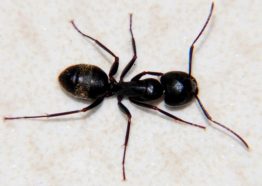Black Carpenter Ants
 Order: Hymenoptera (bees, wasps, ants, sawflies)
Order: Hymenoptera (bees, wasps, ants, sawflies)
Family: Formicidae (ants)
How to identify:
As with most insects, black carpenter ants have six legs and four wings (though only the males and queens have wings). The ants’ unique body shape can be used to identify them, when viewed from the side, as ants have a narrow waist with a nodule, bump, on it (Figure 3) Black carpenter ants are polymorphic meaning that individuals of the species vary in shape and size; carpenter ants are some of the largest ants in North America (Triplehorn et al., 2005, p. 554). Black carpenter ants are, as their name suggests, black. These ants can be distinguished from other black ants by the patch of yellow hairs on their posteriors (Miner, 2013). Note: Velvet ants (Hymenoptera: Mutillidae) are not true ants; they have hairy bodies and lack a nodule on their waists (Figure 3).
Advanced ID: The abdomen attaches narrowly to the thorax. The first abdominal segment is elongated into a petiole, and a nodule is present on this segment. Antennae are 6-13 segments in length and are often geniculate in females. Wings may be present; if wings are present, the wings have normal or slightly reduced venation (Borror & White,1998, pp. 344-346). Black carpenter ants are, like other ants, polymorphic. Black carpenter ants are some of the largest carpenter ants; the large workers of this species range in size from 0.5 to 1.6cm (Miner, 2013). The black carpenter ant is completely black and usually has yellow hairs on their abdomen.
Ecology
Metamorphosis Type: Complete metamorphosis: egg, larva, pupa, adult. Larvae often look very different from adults (e.g., caterpillar and butterfly, maggot and fly).
Geographic Range: Black carpenter ants are found in eastern United States and southeastern Canada
Habitat: Black carpenter ants live in forests. Colonies are established in decaying wood by creating holes. They then expand their colonies by chewing through the surrounding decaying and living wood. They can also live in human-built wooden buildings like sheds, houses, and business offices (Smithsonian Institute, n.d.).
Omnivore: consumes plants and animals.
Scavenger: an animal that feeds on dead plant or animal material.
Food: Carpenter ants, despite their name, do not eat wood. Carpenter ants have mandibulate mouthparts, meaning they have mandibles rather than a straw-like proboscis. They prey on live arthropods and plants, and scavenge dead arthropods. They also consume a sugary substance, called honeydew, from aphids (Smithsonian Institute, n.d.).
Why should we care?
Human Uses: Although black carpenter ants themselves can be considered pests when they invade human buildings or damage wooden structures, they also prey on many other pest species. Thus, the black carpenter ant can help reduce crop loss. These ants can also reduce damage to human structures because black carpenter ants prey on pests more destructive than themselves, like termites (Miner, 2013).Conservation Status: The black carpenter ant is not listed as endangered or threatened (New Jersey Fish & Wildlife, 2012, and IUCN, 2022).
Did you know?
- Carpenter ants, like many other ants, live in colonies and have a caste system: with queens (reproductive females) who mate, found colonies, and lay eggs; reproductive males who die shortly after mating, and workers (non-reproductive females) who protect the nest, dig tunnels, and care for the queen, eggs, and pupae.
- Black carpenter ants have a symbiotic relationship with aphids. The ants raise the aphids like cattle! Aphids (very small insects) drink the liquid flowing through plants and concentrate it in their bodies. The ants carry aphids to a plant each morning, protect them throughout the day, and carry them back to the nest at night. In return, aphids produce a sugary liquid (like maple syrup) from the plant juices that ants drink from the cornicles (Figure 7) on the aphid’s abdomen (Borror & White, 1998, p. 136).
Images Cited
Photo 1: Keith Roragen. 2016. Creative Commons License | Link
Photo 2: Judy Gallagher. 2020. Creative Commons License | Link
Photo 3: Jacy Lucier. 2015. Creative Commons License | Link
Photo 4: Patrick Murray. 2021. Creative Commons License | Link
Photo 5: Ilona L. 2012. Creative Commons License | Link
Photo 6: Patrick Randall. 2014. Creative Commons License | Link
Photo 7: Don Loarie. 2022. Creative Commons License | Link
Photo 8: MJ Hatfield. 2020. Creative Commons License | Link
Researcher’s Biography
Xander Takada
Completed this research within Dr. Shelly Thomas’ Entomology course
Suggested Citation:
Takada, Xander. (2022). Black Carpenter Ants. Rowan University Arboretum. https://arboretum.rowan.edu/learn/explore-insects/black-carpenter-ants/
Questions to Explore
- What factors influence the establishment and growth of Black Carpenter Ant colonies?
- How do Black Carpenter Ants navigate and forage for food, and how does their foraging behavior vary across different seasons and habitats?
- What are the ecological impacts of Black Carpenter Ant colonies on their surrounding environment, and how do they interact with other organisms?
- What are the most effective and sustainable methods for managing Black Carpenter Ant populations in urban and natural environments?
Citations
Baillie, J., & Groombridge, B. (comps. & eds.) (1996). 1996 Iucn Red List of Threatened Animals. lUCN, Gland, Switzerland and Cambridge U.K., and Conservation International, Washington, D.C., U.S.A.
Borror, D. J., & White, R. E. (1998). A field guide to insects: America north of Mexico. (R. T. Peterson, Ed.). Houghton Mifflin.
IUCN. 2022. The IUCN Red List of Threatened Species. Version 2022-2. Retrieved December 20, 2022 | Link
New Jersey Fish & Wildlife. 2012. New Jersey’s Endangered and Threatened Wildlife. Retrieved December 20, 2022 | Link
Miner, A. (2013). Camponotus pennsylvanicus (black carpenter ant). Animal Diversity Web. Retrieved December 8, 2022 | Link
Smithsonian Institution. (n.d.). Carpenter ants. Smithsonian. Retrieved December 1, 2022 | Link
Triplehorn, C. A., Johnson, N. F., & Borror, D. J. (2005). Introduction to the study of insects (7th ed.). Brooks/Cole.








